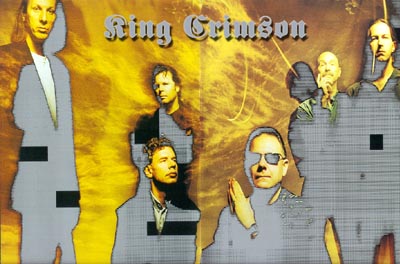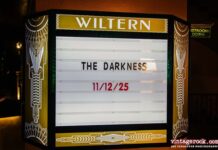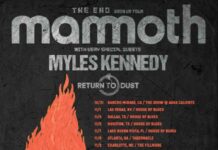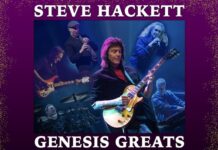Review by Shawn Perry
To quote Robert Fripp, King Crimson can “rip out of the boundaries and shred wallpaper at three miles…”
And who is more qualified to describe the potency behind Crimson than Fripp himself? For over 25 years, the self-styled guitarist, de facto leader and singular constant in the veritable angst of King Crimson has dangled the band’s legacy over a crackling fire — randomly starting and stopping its existence at will; shuffling the bands’ personnel like a deck of jokers, For him, King Crimson is a coveted and precious commodity, fueled supremely by personal interest and challenge in lieu of profits and fame.
Indeed, Fripp is the quintessential artiste with an uncompromising slant. He intentionally steers clear of commerciality and convention due, in part, to its banality and lack of stimulation. Consequently, King Crimson often comes across as a dissertation of the senses — a sonic attack that unfolds, twists, erupts, transcends and eventually boils into an indescribable dialogue of mellifluous proportions.
There couldn’t have been a better place to witness Crimson in action than at the Copley Symphony Hall in San Diego. Far from the clatter and informality of the city’s sports arena, Copley caters to a classical crowd who shy away from mosh pits and stinky restrooms. No wonder the ushers got a bit uneasy when the band opened the show with a bombastic “Vroom,” a driving and impetuous instrumental that appears in several different forms and arrangements on the first new Crimson album in over ten years, THRAK.
The ushers had nothing to worry about. For all the intensity and power dynamically dispensed by this recently reassembled rendition of the band — a six member ensemble referred to, in Frippian terms, as a “double trio”– the audience stayed glued to their seats, politely cheering at the end of songs, otherwise totally transfixed and hypnotically engaged in the cacophonous rumblings that tumbled out of the clean and distortion-free sound system.
Drawing on mostly material derived from the new album, Crimson seemed intent on simply mollifying the listener with its rich tapestries of turbulence, incorporating the best of all styles the band has delved into over the years. They are a progressive unit that swings and rocks, seasoned with pinches of jazz, world and industrial strength. Just enough variety to keep things interesting.
Next to Fripp, Adrian Belew represents the conviction and continuing curiosity in Crimson. As lead vocalist and lyricist for the band since their second coming in the early eighties, his quirky rhapsodies of normalcy are hurled forth in David Byrne-like incantations. Whether or not his words are any more discernible than previous efforts by original lyricist, Pete Sinfield — which eventually landed him a gig with Emerson, Lake and Palmer — remains to be seen. Such perfunctory lines like, ‘People pay to see two people box’ cannot be taken lightly.
Moreover, Belew’s skills as a guitarist cannot be underestimated. Taking cues from former mentor, Frank Zappa, his soaring slide work and thunderous volume swells heave and hoe within the non-linear textures set-up by Fripp, Warr guitar prodigy Trey Gunn and bassist Tony Levin. Visually, Belew was easier to appreciate, standing front and center while Fripp lurked in the shadows, perched upon a stool between percussionists Bill Bruford and Pat Mastelotto.
Collectively, this version of Crimson is far more cohesive and in sync than previous lineups. The 1974 epic “Red” received a dense and vigorous treatment, showcasing fierce and striking virtuosity from each player. We can only hope the temperament of Mr. Fripp will keep this combination intact for another album or two.
Opening the show was the Fripp-sponsored, California Guitar Trio. As graduates of the Fripp League of Crafty Gentlemen, the three acoustic guitarists wowed and dazzled the crowd with tastefully executed favorites like Bach’s “Fugue In D Minor” and Hugo Montenegro’s “The Good, The Bad, & The Ugly.” After their performance, they signed autographs and hawked their CDs — a rather odd ploy, considering they’re endorsed by one of music’s most elusive figures. There’s just no use in trying to figure old Bob out.




















